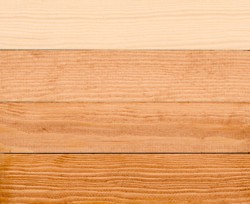 Many refinishing wood projects result in blotched or uneven stains, caused by the stain not evenly penetrating the wood. This is especially common with penetrating stains like wiping stain, since they are difficult to control if you apply too much at first.
Many refinishing wood projects result in blotched or uneven stains, caused by the stain not evenly penetrating the wood. This is especially common with penetrating stains like wiping stain, since they are difficult to control if you apply too much at first.
However, all wood can face this problem, since kiln-dried wood has a variety of areas that are harder or softer than others. This makes the wood look beautiful but can cause problems when staining.Many factors can change how any given wood species absorbs stain; hardness or softness of the wood, grain type, tightness of the grain and the amount of sanding preformed before applying a wood stain.
Sanding is as major factor that must be considered. The finer the sandpaper grit the more closed are the wood pores and the lighter the wood stain color will be. The affects of excessive sanding can be counteracted by raising the grain with water. Check-out Techniques for Staining Wood for more ways to get an even color and nicer looking stained wood.
Benefits of Pre-sealing
Pre-sealing the wood before staining will help guarantee even coloration. It is the best way to prevent having some spots that are very light and some that are too dark. While pre-sealing adds just a little bit of time and effort, the benefits can be immense as this can prevent the disaster of an uneven wood staining job.
Soft woods like pine and fir benefit the most from this process, but there is very little downside to using a pre-stain conditioner on any wood. The worst that can happen is that the color will be lighter than you planned on, and that can always be solved by another coat of stain.
Choosing the Right Pre-stain Conditioner
Pre-stain conditioners are manufactured to work with either water or oil-based stains, so make sure to get the appropriate conditioner for the stain you are going to be working with.
Applying the Pre-stain Conditioner
Generally, the conditioner is applied to the wood and allowed to sit before being wiped off. Follow the manufacturer’s directions, because each sealant is different. If you don’t follow the instructions, you could end up with wood that is over sealed and will not take any stain, defeating the whole purpose.
Fixing a Stain Job with an Uneven Finish
If you have already applied stain without properly conditioning the wood and have very uneven colors, all is not lost. If no finish has been applied, you can use a darker stain to cover up the current one. If you want a lighter color, you will need to remove the stain and any finish, and then condition the wood.
Another possible option is to apply a gel stain over the botched stain job. This will require some practice. Many people find it very difficult to apply gel stain evenly, so use thin coats of the stain. This will help ensure that the wood is a single, solid color without any unevenness in the coloration.
Refinishing wood can be difficult due to the risk of uneven stain absorption and the resulting multiple color effect. If you seal the wood with a conditioner, you’ll be able to apply the stain in an even manner, no matter what type of wood you are staining.


